Abstract
This article provides a comprehensive and chronological account of the technological advancements in alluvial gold mining. Gold has been a highly prized commodity throughout history and has played a significant role in humanity’s economic and cultural progress. The primitive methods of extracting gold from riverbeds were carried out in Ancient Anatolia and Ancient Greece. The earliest references to the extraction of gold from riverbeds can be traced back to the Argonautic expedition and the myth of the “Golden Fleece”. In this myth, fine gold particles were believed to be trapped within the skin of the fleece, thus alluding to the early practices of gold recovery from rivers. Since then, gold extraction and processing technologies have evolved. During the Roman Empire period, Emperor Augustus made significant advancements in hydraulic gold mining. He developed the “ground sluicing” method, which used water to wash away the overlying soil and expose the bedrock where gold deposits were located. Subsequently, the revolutionary pumps described by Georgius Bauer (Agricola) gained significant popularity during the Renaissance. Additionally, Spanish colonialists in America enhanced their techniques by observing the efficient methods employed by the indigenous populations. Finally, the “gold rush” era was perhaps the most crucial period in alluvial gold mining and took place in the rivers of America during the 19th–20th centuries. Today, technologies have evolved significantly, and exploring the evolution of primitive methods to the present is considered essential.
1. Introduction
Gold is a metal whose value has been recognized by all cultures over the centuries for different reasons and was originally extracted from alluvial deposits. Some scientists believe that the exploitation began in the early Iron Age, others in the second half of the 8th century BC, or even in the 7th century BC. More recently, scientists argued that the Pactolus gold was already mined in the third millennium BC. The Egyptians recovered gold on the coasts of the Nile and Sudan (Nubia) approximately in the 5th millennium BC [1]. Analyzing samples with a higher degree of fineness than naturally occurring gold can suggest the use of refining techniques, and the presence of unusual alloys may indicate evidence of such practices in Ancient Egypt. Unfortunately, this method is open to certain difficulties. Ancient Egyptian gold articles are not as common as might be generally expected and are often not available for analysis from crucial time periods. These factors present obstacles to fully comprehending the refining techniques and alloys employed by ancient civilizations such as the Egyptians [2].
According to Greek mythology and historical sources, the ancient Georgian Kingdom of Colchis was renowned for its wealth in “gold sands,” and the indigenous people mined this precious metal from the rivers. They employed special wooden vessels and sheepskins for the extraction process. Apart from the references to the Argonautic expedition by Strabo (book-XII; Pliny the Elder I), the perspective of the Roman historian Apianos Alexandrinos (90–170 AD), who accepted the Argonauts’ trip to the Colchis kingdom in quest of the “Golden Fleece” as a true occurrence, is adopted by analyzing geological information, artifacts, myths, and historical sources [3]. Next, the processes were developed significantly with the introduction of Emperor Augustus’ new mining techniques during the Roman Empire period, such as hydraulic mining (hushing) and ground sluicing methods [4].
The Renaissance period was accompanied by Georgius Agricola’s book “De Re Metallica”, an innovative manual of mining techniques still used in today’s industrially advance era. In particular, Agricola highlights a groundbreaking technical advancement in his writings, describing a new type of pump that brought about a revolution in mining techniques. He applies his rigorous taxonomical approach to detail various types of pumping systems, including both discontinuous methods involving buckets, goatskins, or tubs assisted by ordinary hoists, and continuous methods utilizing a chain of buckets, reciprocating piston pumps, or pater noster pumps. His great work, De Re Metallica, carefully depicted and described all facets of mining from ores to mining machinery. Until that time, Pliny the Elder’s work Historia Naturalis was the main source of information on metals and mining techniques. Agricola acknowledged his debt to ancient authors, such as Pliny and Theophrastus, and made numerous references to Roman works. In geology, Agricola described and illustrated how ore veins occur in and on the ground. He described prospecting for ore veins and surveying in detail, as well as washing the ores to collect the heavier valuable minerals, such as gold and tin. Agricola’s work offers insights into the utilization of water mills in mining operations, including a device designed to raise personnel and materials in and out of mine shafts. Water mills played a significant role in processes like crushing ores to liberate fine particles of gold and other dense minerals. Furthermore, Agricola described their application in operating large bellows to forcefully introduce air into the confined spaces of underground mines [5,6].
Gold was primarily collected from alluvial deposits in the ancient world using gravity techniques and mercury (amalgams) [7], which are still employed today in small-scale alluvial gold resources. Large-scale hard rock mining first employed cyanide in the 1880s to extract commodities, including gold, silver, copper, and other precious metals [7]. New techniques were utilized during the colonization of the Americas by the Spanish, who took advantage of the highly effective procedures of the natives. Refining by amalgamation consisted essentially of grinding the ore to coarse dust and sprinkling a small amount of mercury over it. From this, pure gold could be obtained by applying enough heat to volatilize the mercury. Other ingredients were added to increase the speed and effectiveness of the process: water, to bind the dust into a loose mud; common salt; iron filings; and copper sulphate.
It is acknowledged that the mercury method poses a severe threat to the environment and the miners’ health. Small-scale mining produces the highest mercury emissions (the mercury cycle presented with black arrows in Figure 1), with South America producing 340 tonnes annually [8,9]. Modern industrial and artisanal gold extraction is subject to significantly less stringent enforcement standards than is necessary for industrial mining, particularly in the Amazon Basin region, as demonstrated in the work of Costa and Rios [10]. The effects are also amplified by the widespread use of amalgamating gold with mercury and the localized use of cyanide leaching. Mercury is routinely released into the environment through the latter approach, contaminating waterways and harming all connected ecosystems, including human settlements and the food supply chain [10].
Some of the environmental impacts associated with small-scale gold mining are as follows [11]:
- Mercury pollution;
- Disposal of tailings and effluents into rivers;
- River damage in alluvial areas;
- Erosion damage and deforestation;
- Landscape destruction;
- Socio-economic consequences.
Small-scale alluvial gold miners in Tadó, Dept, Chocó, generate “green gold” using readily available plant extracts as part of a unique method employed in Colombia to substitute mercury. Instead of using mercury, a frothy liquid made from the crushed leaves of Balso (Ochroma pyramidale) and Malva (Hibiscus furcellatus) is poured into the gold pan (type batea) [12].
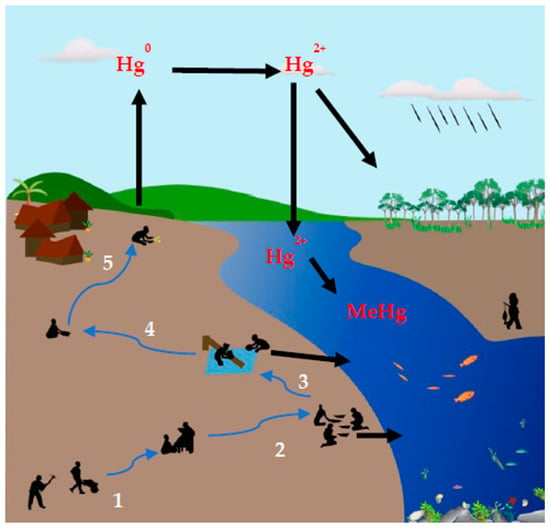
Figure 1.
Gold extracting in small-scale placer involving the stages (presented with blue arrows): (1) excavation, (2) grinding and sifting, (3) washing, (4) panning, and (5) gold–Hg-amalgam burning [8].
Apart from analyzing the abovementioned critical historical periods and the conditions that led to the foundation of the alluvial gold mining and processing methods, the technical characteristics and operating principles of the devices applied from 4000 BC to the present day will be described in detail. Over the years, there have been rapid advancements in gold mining and extraction methods. New machines and methods [13,14,15,16] have been developed in our modern society to enable more precise excavation while minimizing environmental impact. Thus, this article will also thoroughly explore the extensive progression of devices throughout centuries, highlighting their notable advancements and drawing comparisons between them.
2. The Historical Progression of Alluvial Gold Mining and Processing Technologies
2.1. Early Finds of Gold in Greece, Egypt, and Asia Minor (5000–1000 BC)
Gold was first found at the surface level near rivers in Asia Minor, such as the Pactolus in Lydia, and was also mined underground from 2000 BC by the Egyptians and later by the Romans in Africa, Portugal, and Spain. Electrum (a natural alloy of gold and silver) was used in jewellery by the Egyptians from 5000 BC. The Egyptians recovered gold along the Nile and Nubia (Sudan), specifically from the highlands east of the Nile in the Red Sea region. The oldest geological map discovered is the Turin Papyrus of the Wadi Hammamat gold mines and greywacke stone quarries used by ancient Egyptians [17]. The gold was initially derived from eroded surface material and then from underground shafts and tunnels in these deposits. Egypt served as the primary source of gold in the ancient Mediterranean world, holding this prominent position before the peak of Greece’s influence. Before 1500 BC, the Egyptians developed a method known as fire assaying to assess the purity of gold. Chemical analysis as we know it today has its roots in the assaying procedure used to handle precious metals, particularly gold [18].
The initial gold artefacts uncovered in Greece included a gold earring discovered in Dimini, a fortified settlement in Thessaly near Volos, dating back to the early fifth millennium BC. Shortly afterwards, a gold bead was discovered during the Final Neolithic period at the Sitagroi settlement in Drama, also located in Greece (4600–4200 BC). Archaeologists generally agree that the role of gold was associated with people of high social status and symbolized their power and authority. The motivation for producing a noble but impractical metal for the time indicates that its value was more closely linked to the social structure and hierarchy of cultures rather than the metallurgical expertise of the artisans involved [19]. Today, there is evidence that the initial gold production in Asia Minor dates between the Late Chalcolithic and Early Bronze Age. An early example of gold used in Asia Minor comes from the ancient city of Melid (or Arslantepe), where a gold disc was found around 3000 BC. The presence of this artefact, along with a spiral ring found in subsequent royal tombs, suggests the existence of a gold smelting industry that had likely already emerged and was operational inland. During the middle of the third millennium BC, there was considerable interest in the exploration of gold. Its production increased significantly with large quantities of artefacts being made from the second level of the “Troy” excavation, in the catacombs of Alaca Höyük and other sites in the Eastern Mediterranean, particularly in the royal tombs of the city of Ur (Mesopotamia). The enduring fascination with gold in Anatolia (Asia Minor in Greek) during this period could be attributed to the dynamic changes that occurred due to metallurgical operations: extensive exploitation of polymetallic ore deposits took place, the population increased, and a socially based demand for luxury goods developed in earnest [20].
The high demand for gold led to the depletion of primary sources. It is believed that at some point, alluvial and placer deposits could no longer provide the necessary quantities of gold. As a result, miners of the time moved to different sources. They quickly realized that the gold-bearing ores accumulating in the rivers came from an initially higher altitude, and it took them only a short time to detect their primary source. In this case, the gold was trapped in the host rock, commonly in amalgamated quartz at the highest point. Gold was initially subjected to a panning process. In order to achieve separation from the gangue minerals, the miners carried out the scrubbing process in which the gold-bearing quartz was washed by the action of water. Then, the pulp was poured onto a shaking table, with the heavier particles collected in its holes and pockets. The process mentioned above could be repeated as many times as possible to obtain the highest possible quantity of gold without the existence of gangue minerals [20]. Since the New Kingdom, gold has been recovered from quartz ores found in the weathered debris of the wadi beds, in addition to the mined gold quartz veins that are visible at the surface. So-called placers or nuggets had a minor significance in Egypt’s ancient gold mining history due to the arid environment. Such placers had, however, at the latest, been extracted since the Early Arab Period, typically in the form of extremely fine gold grains from alluvial sands in the wadi beds.
2.2. The Argonautic Expedition and the Retrieval of Gold from the Riverbeds of COLCHIS (1330 BC)
The mountains of the Caucasus have had a strong connection with gold for millennia. According to the legends told by Greek and Roman writers, Jason was sent on an impossible mission to find the Golden Fleece in Colchis (a part of today’s Georgia in Eastern Europe) [21], from which his usurper uncle and king of Iolkos, Pelias, assumed he would never return. The rivers flowing through Colchis, particularly in the Svaneti province, carried coarse sand and particles of gold. The local inhabitants employed special wooden sluice boxes designed to concentrate the sands, with the finer fractions being captured in the lower section of the device, lined with sheepskin. The remarkable and distinctive mechanism described above gave rise to the legend of the Golden Fleece, which originated in a country with abundant silver palaces and golden halls of ancient kings. Thus, the legend of the magnificent wealth of Colchis, like the rumours of the wealth of its rulers, is said to have excited the business avarice of the Argonauts [22].
Appian of Alexandria, a Greek-born Roman historian (90–170 BC), and other historians expressed that actual mining practices inspired the Golden Fleece. The description of the Golden Fleece alludes to the use of sheepskin to extract gold from riverbeds (Figure 2).
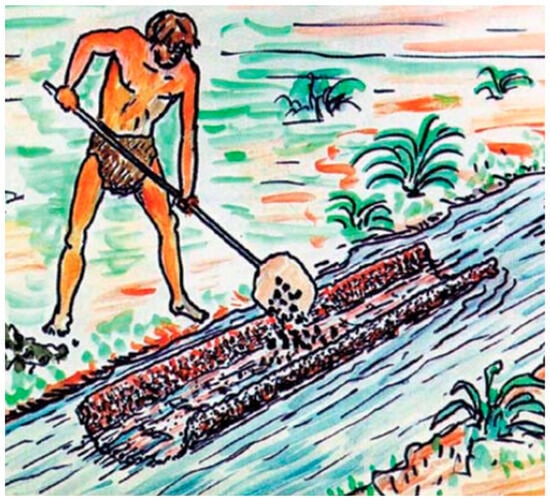
Figure 2.
Representation of the use of the sluice-box. Its wooden base is covered by a fleece [23].
The Argonauts, on their return to Iolkos, avoided the Aegean and followed the sea routes of the central Mediterranean and the rivers of southern Europe. They passed through the great mining centers along the Danube, located mainly in the areas of Ai Bunar (Bulgaria) and Rudna Glava (Serbia), where copper was mined from the large deposits of gold in Transylvania, as well as in the southwestern part of Danube (Erzgebirge, Germany). From there, the Argo sailed via the Adriatic to the Rhone and the Eridanos (a river in Northern Europe mentioned in Greek mythology and historiography), the rivers south of the Alps, on whose banks were concentrated deposits of copper, iron, lead, and gold. The Argonauts reached Egypt and finally the Aegean, stopping in Crete and Thera, which was the intermediate station for imports from the Aegean to Crete (Figure 3) [24].
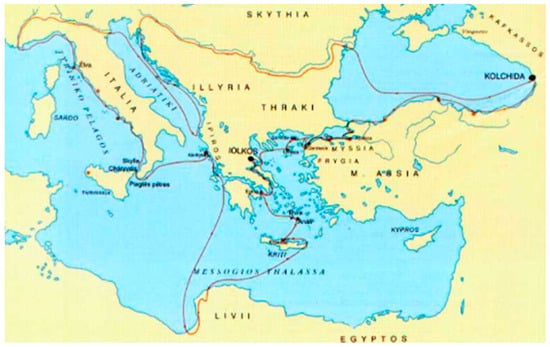
Figure 3.
The path taken by the Argonauts and the regions containing the most significant deposits of the era [23,24].
2.3. The Revolutionary Techniques for Processing Alluvial Gold Deposits during the Roman Empire Era (27 BC–476 AD)
The growth of the Roman Empire demonstrated a significant need for metals, leading to the search for additional sources. Gold mining played a crucial role within the territories of the Roman Empire, including those conquered, primarily serving to support the military and its infrastructure. Over time, gold gained prominence and became a vital foundation of Roman society. It served not only as a currency during that era but also as an indicator of wealth and a catalyst for global trade. The Romans mined at least fourteen locations for gold, copper, and silver. In the Astur region, Aurifers were primarily found in Galicia and Lusitania, according to Rodrigues [25]. The Porto area in this final region had the most well-known mines [26]. The Ruina Montium method, the most impressive mining technique invented by Roman engineering and recorded by Pliny in his Natural History, was used in several mines [27]. The same concept was applied in Roman settlements on Portuguese territor. This method required moving an extensive amount of water to the area to be exploited and building channels (80 to 100 km) and reservoirs with a maximum capacity of 18,000 m3. The ruina montium was built using the methodical application of hydraulic force [28,29]. The flow of water (Figure 4a) through the excavation system leads to the erosion of the mountain. Such an excavation is marked with the red arrow in Figure 4b.
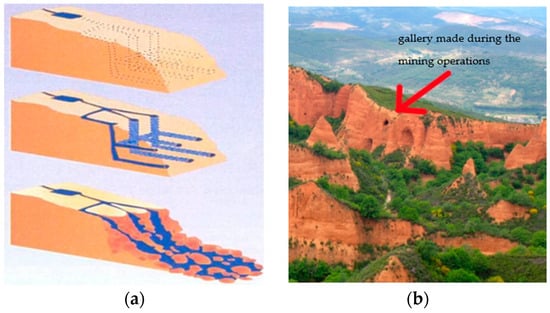
Figure 4.
Ruina montium method to Las Médulas [28] (a) water flow erosion; (b) remaining gallery from the operations.
For the most part, gold and other metals were mined by hand. However, a significant breakthrough came with the invention of hydraulic mining, a technique that greatly enhanced production levels. Hydraulic mining, also known as hushing, is an age-old mining technology that uses a powerful stream of water to remove impurities and uncover mineral veins. During the most profitable mining period, it is estimated that the Roman Empire produced up to 9 tonnes of gold per year. Considering today’s gold prices, this production level would generate over half a billion dollars in yearly gold revenue [30].
The Romans employed a range of techniques to extract metals from the overall composition of the ore. Specifically, gold underwent two primary refining processes. One approach involved heating the gold for an extended period alongside other substances, either metallic or non-metallic, using a process known as cementation or refining. Another method was the process of amalgamation with mercury, which is one of the earliest techniques for gold extraction. It involves the amalgamation of Au from Hg and then the distillation of Hg from the Au-Hg amalgam, producing spongy gold and mercury vapour [31].
The initial stages of exploiting alluvial gold involved leaching and crushing the gold-bearing rocks. These two operations could be conducted simultaneously and/or continuously depending on the mass to be extracted and the volume of water supplied. The open-pit mines provide ample evidence of the various leaching methods, such as selective operations in which convergent trenching (Las Cavenes) was applied when gold was located at higher altitudes (Figure 5). Gaius Plinius Secundus, a Roman author who lived from 23 to 79 AD, described the leaching of copper and subsequent evaporation of copper sulphate solutions [32], evident that the technique was used in Roman’s Empire era.
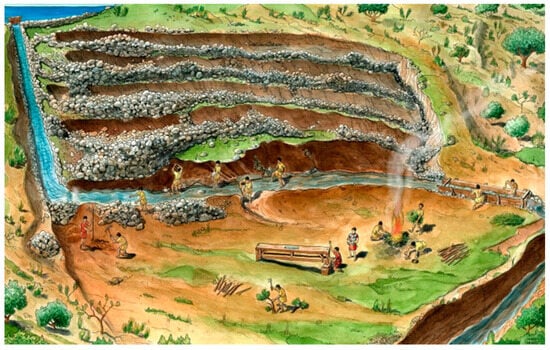
Figure 5.
Exploiting alluvial gold deposits using hydraulic mining (Project: Hugo Prades-Fundación Las Medulas, scientific supervision: CSIC) [33].
Figure 5 presents a detailed depiction of the secondary gold mining process using hydraulic power. The drawing depicts the water tank (from which water is supplied to the mining operation through a channel), the use of trenches to move the conglomerate materials to the lower section, the miners removing the larger boulders manually, and the sluice box devices used to wash the conglomerates and separate gold particles of different sizes. In general, this specific technique is known as “ground sluicing”, and it was particularly suited for mining deposits with a thickness ranging from 4 to 6 m. When dealing with dry soils, they would create 6 to 8 converging trenches, each inclined at a 5% angle relative to the horizontal plane. By utilizing the force of running water, the miners would push the alluvial deposits towards the trench walls, gradually driving them downwards along the slope. The pebbles were washed and removed from the trench while the flowing water carried the sand and clay towards the outlet. Consequently, the heavier fraction of the material settled at the bottom of the trenches, allowing for the recovery of gold grains via concentration pans (Figure 6) [34].
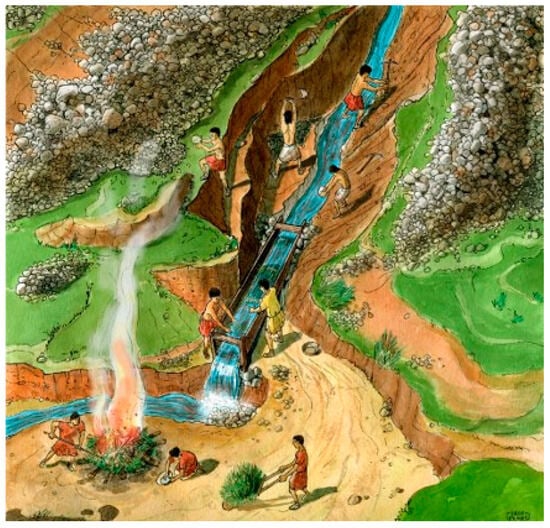
Figure 6.
A different illustration of the exploitation of alluvial gold reserves using hydraulic power [33].
2.4. The Colonialism of the Americas and the Evolution of Indigenous Mining Techniques (1492–1511)
During the Spanish colonization of the Americas, mines such as the well-known Potosí silver mines of southern Bolivia and the cinnabar mines of Huancavelica were significant operations controlled by the Spanish crown. Most evidence indicates that Inca mining was also quite extensive. They considered that gold symbolizes power and wealth and had been sent by the gods. As a result, gold played a significant role in Inca culture, both in religious rituals and in everyday life. According to historical sources, Incas had a complex system for mining, refining, and processing gold. The metal was mined from the Andes mountains and the Incas would extract it from the ore using the amalgamation process, which involved mixing ground gold ore with mercury. Then, the mercury–gold amalgam was burned in order to valorize the mercury and recover the gold [35]. The Incas had also developed efficient ways to control the production of wealth and systems of state control involving complex mining techniques that required central coordination of the workforce [36,37,38].
All European rulers coveted gold when Christopher Columbus (1451–1506) landed in the Americas in 1492. In 1494, the conquistadors made their first gold discovery on the island of Hispaniola (now the Dominican Republic/Haiti) [39]. The Spanish empire then reached Cuba, which at the time was the best gold source, Puerto Rico in 1508, Jamaica in 1509, and Puerto Rico again in 1511. Spain became the richest nation in the world due to the conquistadors’ incredible gold discoveries in the Americas. During the Spanish colonization of the American continent, miners began exploiting alluvial deposits as a starting point. The simplest method employed was the processing of conglomerates and sands located in rivers and lake bottoms using the gold concentration pans. At the same time, the use of sluice box devices was widespread in gold processing and was carried out in colonial New Granada. To implement this method, workers constructed a channel or dam beneath the surface containing mineral deposits or along slopes. By excavating the ground, they created a designated area for treatment. Subsequently, the soil from the site was carefully removed and fed into the sluice box device. In some cases, workers would direct the water flow towards the treatment surface, using its power to help excavate.
Within these open-pit mines, a network of bamboo pipes was constructed, serving as small aqueducts to transport water from higher locations to the treatment zones where sluice boxes were located. The water would flow through the sluice boxes, causing the settlement of the larger minerals in the lower section of the device. Then, the workers would hand-sort the gold particles and remove the residue from the apparatus, which could be processed using gold concentration pans. By adding water to the mixture in the pan and shaking it vigorously, they could separate the lighter material from the top of the device. Consequently, the heavier material, including the concentrated gold, would settle at the bottom of the pan. Miners used many different techniques to separate metals from the bulk of the ore. When dealing with black sands containing gold flakes and iron oxides, miners adopted the approach of the natives. They would mix the concentrate with the sap derived from tropical plants, producing a foamy and sticky material that caused the “iron oxide flakes” to stick to its surface. As a result, pure gold would settle in the lower part of the ‘batea’s (open conical dish) gold concentration pan. In the 1880s, the technique of using magnets by Europeans could also help separate iron oxides from gold. In the Chocó region of northwestern Colombia, gold often appeared with platinum, and miners used mercury to separate the two metals at the time. However, until the mid-eighteenth century, platinum—Platino as it was called for its similarity to silver—was considered of little value [40].
2.5. The Pioneering Machine Designs by Georgius Bauer Agricola (1494–1556)
After the fall of the Roman Empire (476 AD), there was a notable shift in demand for minerals and metals from the Mediterranean region to the highly productive mines of central Europe. During the early Renaissance (15th century AD), mining and metallurgy developed significantly. During this period, metal production reached unprecedented levels, setting new records, and constantly evolving as innovative technologies were employed. The primary sources of information regarding metallurgy and mining during that period were Georgius Agricola and Vannoccio Biringuccio, who made substantial contributions. Their main works, Pirotechnia (1540) and De Re Metallica (1556), covered most of the topics related to mining and metallurgy and became standard textbooks for the next two centuries.
In 1556, almost a year after the death of its author, De Re Metallica was published in Basel. The publication of this book marked a crucial transition from the philosophical realm of metallurgy to a more empirical and scientifically grounded approach based on careful observation. Thus, De Re Metallica represents the first attempt to describe the nature, location, and means of obtaining and purifying metals from experience and experimentation. It is reflected in the ability to replicate the processes and experiments as they unfold and in the accuracy and detail with which they are described. Agricola’s De Re Metallica is considered one of the most famous engineering manuals of the 16th century. In his work, Agricola delves into the advanced machinery of the Erzgebirge (Germany) mines, mainly using pumps for water drainage and hoists for ore extraction. More specifically, readers can find thorough depictions of the various devices utilized for pumping water out of wells, as the excessive presence of water hinders mining activities. Unregulated water supply poses challenges to the efficient execution of underground mining operations. In cases where a proper drainage system is absent, it becomes crucial to excavate an appropriate well and construct a pump to control the water table [41].
The three innovative types of pumps that Agricola is presenting for the first time are the following:
- Bucket-line pumps;
- Pater noster pumps;
- Piston pumps.
Agricola described and made detailed sketches of a series of water pumps that revolutionized the mining techniques. Agricola described in pictorial detail the methodologies and equipment used in Chapter VIII of the translated book De Re Metallica [42]. Agricola focused much of his attention on the procedures for washing and isolating metal from gangue. Forty-nine exquisite drawings depicting a variety of troughs, sluices, launders, weirs, and ditches for directing the ore and combining it with water to separate the fine grains from the lumps serve as illustrations of the equipment for washing ore. The heavier grains of metal that flowed down the troughs were caught and held by various mechanisms in these troughs and launders. Others featured cleats, rifles, skins, cloth, twigs, and sieves, whereas some were lined with boards. Also demonstrated was the art of whirling bowls with various capturing devices (Figure 7). The commonly used tools, including rakes, brooms, hoes, and trowels, were considered agitators.
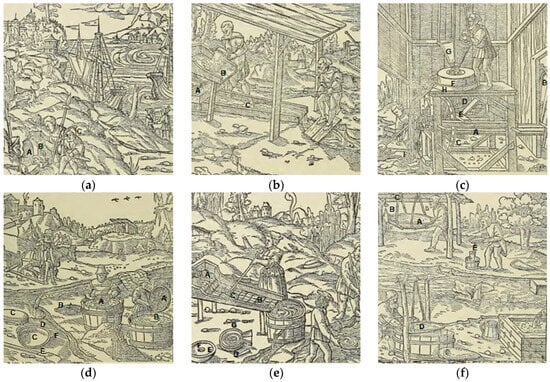
Figure 7.
(a) The Argonauts using the fleece’s skin to extract gold from the riverbeds of Colchis; (b) trough with wooden scrubber for washing the metalliferous ores; (c) Agricola’s millstone complex system for material’s further milling; (d) Bohemians baskets one of the first methods of gold panning; (e) one of the first sluice box systems; (f) bowls used as gold concentration pans [43].
The Colchians threw animal skins (B) into the springs’ pools (A), and when they were taken out, they were covered in gold particles. The “golden fleece” and the Argonauts’ expedition (C) were created by poets (Figure 7a).
Before developing the short strake and jigging sieve, metalliferous ores, mainly tin, were dried, crushed with stamps, and washed in a large trough (A) hollowed out of one or more tree trunks. At the head of this trough was a platform (B), on which the ore was thrown after being completely crushed. The washer used a wooden scrubber (C) with a long handle to lower the ore into the trough. Once the water had been allowed to enter the trough, the same scrubber was used to agitate the ore (Figure 7b).
Figure 7c displays this information. The water wheel (B) that drives Agricola’s millstone complex system has an axle (A) that is mortised and a toothed drum (C) with teeth set in the side of the rim. These teeth rotate a second drum of extraordinarily durable rundles (D). This drum is positioned around an iron axle (E) that rotates in an iron cup in timber and has a pinion at the bottom. An iron tongue dovetailed into the millstone (F) is attached to the top of the iron axle, which causes the millstone to rotate when the teeth of one drum spin over the rundles of the other. It receives ore from an overhanging machine through a hopper (G) and, after being ground to a powder, is discharged from a round wooden plate (H) into a trough (I), where it flows away and collects on the floor before being transported away and set aside for washing.
In Figure 7d, the Bohemians utilize an osier-tied basket (A) that is a foot and a half wide and deep. It has two handles (B), which hold onto it when moving and shaking it in a bathtub or a small pool almost filled with water. They remove and wash everything that passes through it in a bowl (C), which is higher in the back part (D) and lower and fiat in the front (E). The bowl is shaken in the water while being held by the two handles (F), with the lighter particles floating away and the heavier and mineral portion sinking to the bottom.
One of the first sluice devices was described by Agricola, as shown in Figure 7e. It is situated in a river, stream, or bank and is supported by two stools, the first of which is higher than the second to allow gravel and small stones to flow down the sluice. The washer uses a shovel to deposit sand into the head (A) and then opens the washer to let the water in. The water then drags metal fragments and some sand down into the riffles (B), while the remaining sand and gravel fall into a tub below the sluice. He removes the concentrates and washes them in a bowl when the riffles are full (G, E).
In Figure 7f, the sand is washed in a sizable bowl that can be easily shaken and suspended from a building beam by two ropes. The separation is created using the same theory as contemporary panning. There are only three handles on the bowl (D), one of which they hold in their hands when they shake it. The other two handles are fastened with a rope used to hang the bowl from a ceiling or a crosspiece supported by the forks of two upright posts staked into the ground. In order to examine the ore, miners frequently wash it in a small bowl (E). This bowl is shaken while being held in one hand and banged with the other.
2.6. The Gold Rush Era in the Rivers of Western America (19th–Early 20th Century)
In 1849, a wave of people known as “49 ers” made an effort to make the long journey to California. By the end of the year, the non-native population in America had grown to about 100,000, a significant increase compared to 20,000 at the end of 1848 and only 800 in March 1848. Gold mining towns developed across the territory to serve the needs of the 49 ers, looking for profitability by this time. Following 1850, surface gold in California largely disappeared, even as miners continued to arrive. However, gold mining continued through the 1850s, peaking in 1852 when total profits from production reached about $81 million. After that year, total annual profits gradually decreased to $45 million by 1857. Settlement in California continued; however, by the decade’s end, the state’s population declined significantly [44].
During the gold rush period, the extraction of alluvial deposits was based on manual labour and water-based methods, thus mining sites were usually located along streams in tributary canyons. Miners used various equipment, including rocker (or cradle) boxes, Long Toms, and sluice boxes, and handheld equipment like pans, picks, and shovels. As time passed, more advanced techniques for mining alluvial deposits were adopted. The construction of dams, water pumps, and ditch-fed sluicing systems became essential for efficient operations.
The introduction of hydraulic mining was one of the most significant improvements in mining alluvial deposits. Miners using these systems provided high-pressure water to wash away the overburdened materials and direct the gold-bearing particles into the sluice boxes. Water cannons, presented in Figure 8, played a vital role in removing impurities and overburden during the mining process. Smaller cannons were also used for washing the gold-bearing gravels within sluice box systems. Hydraulic mining systems flourished from the 1860s to the mid-1880s, when one of the first lawsuits concerning the generation of environmental pollutants was filed, which led to the strict control and end of this process [44]. Dredging was the final evolution of the mining methods for the alluvial deposits of the period, the most successful forms of dredging operated during the 20th century. The dredging fields were located at low altitudes, usually where rivers or large tributary streams emerged from the mountains. It is worth mentioning that the dregging technology originated in New Zealand in 1882. The largest gathering of dredges at work was reported in 1900 with 187 dredges operating among the gravels of the Clutha.
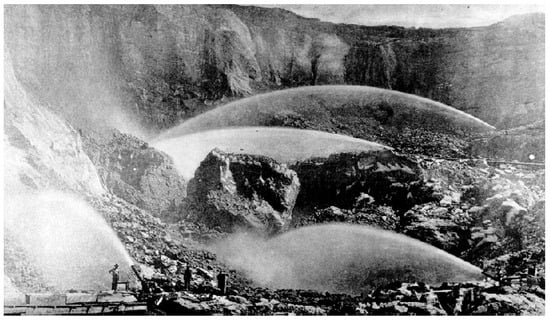
Figure 8.
Hydraulic mining at Malakoff Diggings (Historic photograph taken by Watkins) [45].
3. The Fundamental Alluvial Gold Processing Systems of the “Gold Rush” Era
The “gold rush” era emerged in the rivers of United States the 19th century. This significant period witnessed extensive exploration and mining of alluvial gold deposits, marking a groundbreaking milestone in human history. Moreover, it laid the foundation for the ongoing development of methods and processes employed in alluvial gold extraction [46,47].
3.1. The Miner’s Gold Pan
The gold concentration pans were one of the earliest methods of mineral separation based on mineral density and particle size differences. The pan must be filled with material and submerged beneath the water’s surface to begin the panning process, ideally in a shallow lake or river, with the top end just below the waterline. Once the pan is positioned on the bottom, the material is manually processed, carefully breaking up any lumps that may be present on the surface. If clay is detected within the sample, the clay particles must be broken down manually through the flow of water in the pan. It is essential to wash away and remove any large boulders, a process carried out manually at this initial stage and without using a screen plate [48].
In the next step, the operator holds the pan and performs a vigorous back-and-forth (clockwise and counterclockwise) agitation while keeping it at the same immersion level. As a result, the denser minerals tend to move to the bottom of the pan. If performed correctly, this step causes the smaller and heavier grains to shift downwards while the larger and lighter ones are shifted to the surface of the pan. This technique allows the pebble-sized rocks to be separated from the concentration pan by hand. Afterwards, the pan is partially raised above the water surface and tilted forward slightly while transitioning from a rotary to a flat circular movement [49]. The removal rate of the lighter particles is regulated by changing the height of the concentration pan and performing the lateral movement in combination with the flat circular movement (Figure 9).
The final separation of gold from other minerals can be achieved using various techniques. Larger pieces can be collected with pliers or the tip of a knife, whereas smaller pieces can be collected by pressing them with the tip of a wooden match or the dry tip of a finger. Gold can be most easily removed by blowing it away when there is a sufficient concentration of black sand. The process is continued until only the heavier fraction of the ‘black sand’ (such as ilmenite, magnetite, and pyrite) remains within the pan. The material is then dried, and finally the gold is recovered (probable after using a magnet to remove some of the black sand) [48].
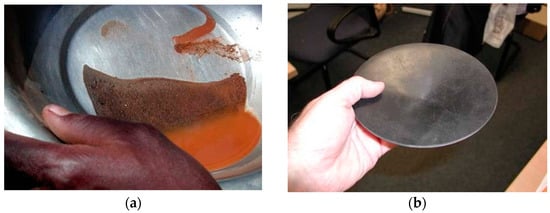
Figure 9.
(a) Aluminum kitchen bowl used as a gold pan (Sudan); (b) small rubber-coated batea for testing the ore (Peru) [50].
The evolution of gold pans from North America to the shape of the South American batea is ilustrated in Figure 10:
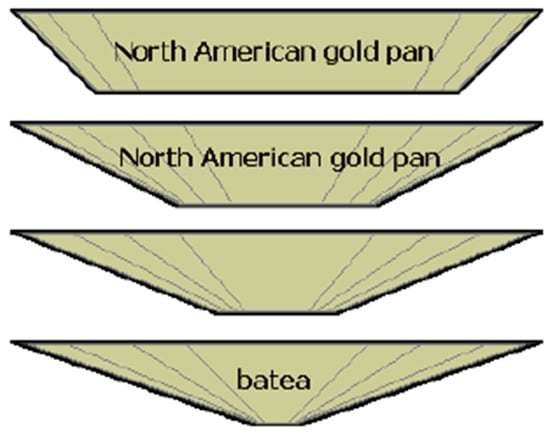
Figure 10.
Evolution of gold pans [49].
3.2. The Rocker or Cradle Boxes
Figure 11 presents a rocker or cradle, named for its resemblance to a child’s cradle, which was operated by a single operator, but in some locations, such as the Nome coast, miners built large machines that could be fed multiple quantities of pebbles. Rocker boxes generally allowed miners to process two or even three times more pebbles than gold concentration pans. The conglomerates are fed into the hopper (H) of the box, and the rocker machine is vigorously shaken back with handle (L) and forth while water flows over the conglomerates. The agitation of the box is particularly important for separating and recovering fine materials.
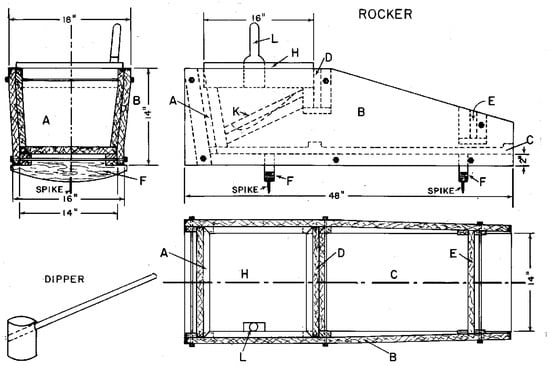
Figure 11.
Diagram of a rocker box with dot lines inside view representing not visible wedges of rocker [51].
The water rate flow is also a crucial factor. If an excessive amount of water is supplied, the gold may pass through the screen (K) without being retained, whereas less water can lead to the formation of clay that transports the fine gold away. The water can be supplied manually or through a hose, and it is important to maintain a consistent flow in the box. Once all the material passes through the screen, it is discarded, and new material is added. This process continues until it becomes necessary to clean the collection apron. Regular cleaning is essential for achieving the highest possible recovery of gold.
The collection apron is removed and washed carefully for cleaning, whereas the riffles (C) are cleaned less frequently when sand accumulates on their surface. After cleaning, the rocker box is reassembled, and the treatment is continued. The concentrates collected are further refined, usually via amalgamation with mercury or gold concentration pans. Sometimes mercury is added to the riffles to facilitate the collection of fine gold, which is extracted from the ore in the form of amalgam (an alloy with mercury as its main component). The amalgam is then heated until the mercury evaporates, and the gold is separated [51].
3.3. The Sluice Boxes and the Long Tom
Sluice boxes are inclined devices that resemble a trough and are equipped with a mechanism designed to capture gold (or other mineral particles) in their flat lower section. In a broader sense, sluice box devices can be utilized to process both alluvial and primary ores. Specifically, the ore is mixed with water, resulting in a pulp that flows into the device’s interior. Throughout history, various of materials have been employed in the construction of sluice box machines. For instance, animal skins were commonly used in ancient times as a base material for trapping gold particles of different sizes. When used correctly, sluice boxes can be highly effective in separating gold from the gangue minerals, which have no economic value. While sluice devices may not necessarily be more efficient than gold concentration pans, their ability to process large quantities of ore enables miners to increase their earnings significantly.
The operation of sluice boxes relies on the principle that heavier particles tend to settle at the bottom of a water stream. In comparison, lighter particles are carried along with the water flow and eventually removed at the end of the apparatus. These devices come in various sizes and dimensions, ranging from small sluices that require manual feeding to large ones used in dredging operations. A well-designed sluice box ensures that the maximum amount of gold will remain in the lower part of the device, where appropriate accessories, such as collection aprons or riffles can trap it. These trapping accessories are designed to capture and retain the gold particles, preventing their re-entry into the stream flow, which may occur due to turbulent forces. Thus, the valuable fine materials of gold are retained in the device and are not washed out of the sluice box [50].
Being denser and having a relatively simple structure, gold tends to settle to the bottom more rapidly compared to silica and other complex materials. The particles’ density, size and shape determine the displacement rate. Large, higher-density, spherical particles shift downward rapidly, in contrast to small, lower-density, less spherical particles, which shift much more slowly. Furthermore, coarse, low-density particles and finer, high-density particles are displaced at the same rates. In sluice boxes where no strong turbulent flow develops, the difference in displacement rate between the lighter and heavier particles leads to the separation of the slurry into stratified zones. More specifically, the pulp stream flows along the sluice, with the higher density and larger size particles accumulating in a zone near the bottom, in which they can be trapped within the coated collection apron and finally removed from the stream. In contrast, lighter particles remain near the stream’s top and are removed at the discharge end of the sluice box.
The pulp’s flow must be adjusted to the size range of the gold particles in the feed and the trapping mechanism employed to ensure the efficient operation of the sluice box. Specifically, the feed rate should be fast enough to prevent the trap spaces formed by the collection aprons from being covered with sand or other aggregates. However, the feed flow should not exceed a certain speed to enable the maximum amount of gold to be displaced towards the lower part of the device, where it can be effectively retained. Striking the right balance between these factors is crucial for optimizing the performance of the sluice boxes.
The increase in the slope of the sluice box is proportional to the flow velocity. Additionally, increasing the depth at which the pulp enters the sluice, either by narrowing the width or enlarging the inlet, also increases flow velocity. For a given feed rate and a predetermined device width, the optimum flow velocity is determined empirically by gradually increasing the angle of inclination until the trap mechanism is free of silica or other materials (or vice versa, decreasing the angle of inclination until the sluice begins to remove sand, and then increasing it minimally) [50,52].
Among the many types of sluice boxes, the Long Tom type is presented in this paper because of its simplicity and potential usefulness. The Long Tom is a small sluice that uses less water than a regular one. It uses much less water than a typical sluice box device but requires more manual labour to operate efficiently. The material is fed into the upper box and washed directly with water. An operator breaks down the material, passes it through the screen and manually removes the larger particles. The coarse gold particles remain in the upper box, while the fine gold particles remain in the lower box. In general, the capacity of such a device ranges from 2.3 to 4.6 m3 per day (Figure 12) [51].
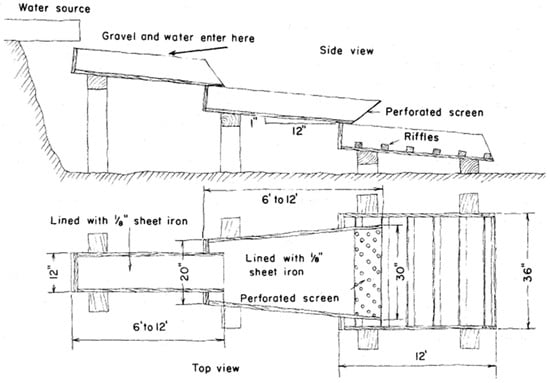
Figure 12.
The Long Tom sluice. Side view and floor plan [53].
3.4. The Gold Dredges
A typical gold dredger has a floating surface that supports the entire structure. It includes a digging arm equipped with a chain on which digging buckets are mounted. Additionally, the dredger incorporates a screening device and gold recovery equipment. The initial use of the dredging method in mining alluvial deposits began in New Zealand in 1882, and its first successful application in the United States took place in the Bannack of Montana in 1894 [54]. Thus, dredging ensured that the river pebbles could be dredged along the entire river in search of gold while at the same time the waste material was deposited in piles formed behind the dredging unit.
Dredge mining equipment is used in the gold recovery process, and it is operated by mechanical hydraulic paddle systems [55,56]. A total of 60–70% of the 0.25 mm metal fraction is lost during the hydroelevation and dredging processes used to process waste sands, while gold particles smaller than 0.1 mm are actually entirely washed away into the tailings. The so-called “rebellious” gold [13], which consists of medium-sized gold particles with a high flattening factor and deformed surface, is entrained by water flow. A grade of ore-preparation wastes contains tens or even hundreds of grams of metal per ton, which supports this claim. Hydraulic systems were not widely applied. In contrast, mechanical systems were classified into two different types:
- Floating dredging devicesFloating bucket line dredges consist of heavy steel buckets supported on a steel chain that rotates over the strong dredging arm. In general, much power is required to support continuous and multi-bucket excavation and transport of the ore. Therefore, dredges are large and very heavy structures, weighing 7000 to 8000 tons, with an excavation capacity of 1000 to 2000 m3 per hour of operation. The operating rate and performance of a floating dredge with a bucket line are determined by the conditions of the ground to be excavated. In general, most dredgers will dredge 20 to 24 buckets per minute regardless of local conditions, whereas good, sandy ground will be dredged at up to 30 buckets per minute [57].
- Land excavators with floating washing devices (portable or fixed)During the 1930s, land dredging for gold mining introduced cranes, wire ropes, and mechanical excavators. The “dragline” have a mobile power unit that supports a rotating arm and a bucket. The bucket is controlled by wire ropes, allowing it to scrape and load materials and direct them to the power unit. These buckets often have a special cutting lip designed to scrape the upper layers of the rocky soil. Generally, this type of dredge only operates from the banks (dry) and moves backwards when the pond water approaches the operating unit. Each shift includes a machine lubricator, a supervisor and two repairers (Figure 13) [58]. The hydraulic excavator “power shovel” has a suitable unit for loading and excavating the sediments, which consists of a forward-pushing shovel mounted on a rigid arm. During the 1890s–1910s, these excavators were often mounted on floating dredges. Bucket capacities ranged from 0.2 to 15.3 m3, with buckets of 1.52 m3 being the most common choice.
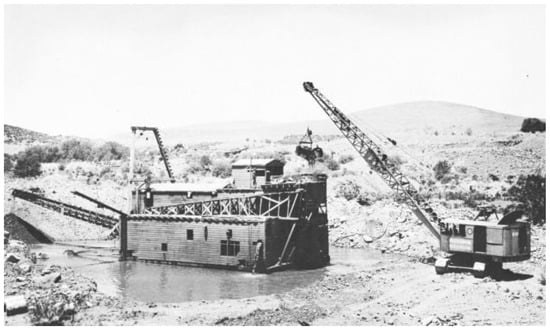
Figure 13.
Dredge operated in Lynx Creek by the Calari dredging Co., 1933. Capacity of 100 cubic yards per hour [59].
The proportion of gold that is easier to access has been largely depleted, and it is economically impractical to develop deposits with difficult mining and geological conditions.
3.5. Gold Rushes over the World
One example of technological innovation’s role in migration is the adoption of mining techniques from Cornwall during the Australian gold rush, which occurred in 1851. These cutting-edge techniques relied extensively on dependable water sources, so miners created advanced technical and legal mechanisms to control the water supply to ensure their success [60,61,62]. Special techniques are involved using bucket dredging and hydraulic sluicing pumps and puddlers (ring-shaped trough in the ground for puddling gold from auriferous clay) [63] (Figure 14).
Today, Australia produces 10% of the world’s gold while the largest producer is China with 13% [64]. Other cases of gold rushes are as follows:
- Gold rush in Georgia of USA: Gold was discovered in Dahlonega named after the Cherokee word for gold. Georgia gold rush occurred two decades before the Californian [65].
- Otago Gold rush occurred during the 1860s in New Zealand. Otago show evidence of an array of mining techniques, including ground sluicing, hydraulic sluicing, and hydraulic elevating [66], and gold winning by bucket dredge is a development that began in Otago.
- The development of Johannesburg, South Africa, was a result of the Witwatersrand gold rush [67], which started in 1886.
- Gold rush in Klondike: Skookum Jim Mason, Tagish Charlie, and Seattleite George Carmack discovered gold in Rabbit Creek, close to Dawson, in the Yukon region of Canada on 16 August 1896. The brook was immediately named Bonanza Brook, and many locals started making claims. Most of these early investors, known as the “Klondike Kings”, realized that gold was found everywhere [68,69].
- Brazilian gold rush: Since its first stages during Portuguese colonial times, the Miguel Burnier mining district has played a role in Brazil’s mining history. The area was established during the longest gold rush in history, the Brazilian gold rush, which lasted from the late seventeenth to the early nineteenth century and had a significant impact on Brazil [70]. Different types of gold were found during the 18th century in Brazil using disparate mining techniques. In Minas Gerais province, large quantities of platinum in the metal generated the well-known ‘white’ gold. In some other regions (Quadrangle of Brazil), gold had a darkened and shiny appearance (black gold), rich in platinum, palladium, iron, and manganese [10,71,72].
- Tierra del Fuego gold rush in Argentina [73] between 1883 and 1906.
- Gold rush in modern Mongolia [74].
- Gold rush in the Andes [75].
- Russia was one of the major producers of gold in the 19th and 20th centuries. Gold rush started in Southern Siberia in the 1830s, with hundred alluvial deposits found in Altay, Sayan, and Eniseysky Kriazh mountains [76]. The gold was initially extracted by hand and by using the amalgamation technique; it was after 1861 with rapid industrial development that the operations were mechanized. Later in the 19th century, the dredging technique was introduced as a gold extraction method [76]. Elmina’s gold rush occurred in Ghana [77].
- Environmental problems have been brought on by the recent gold rush in Indonesia and the lengthy history of artisanal gold mining [78].
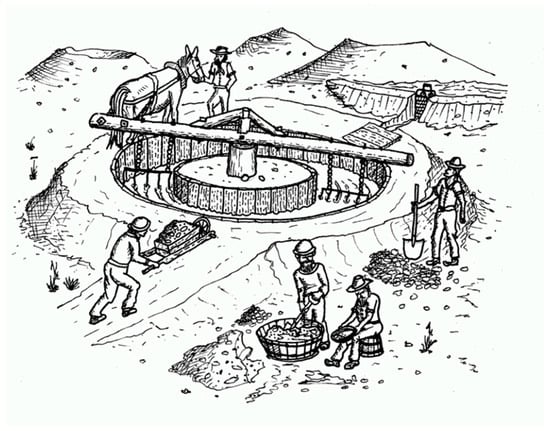
Figure 14.
A puddling machine (Available online: https://www.egold.net.au/ (accessed on 1 August 2023)).
4. Waterless Alluvial Gold Processing Equipment
4.1. The Dry Washers
Dry washers (Figure 15) are among the most widely used gold recovery devices that operate without a water supply. Gold dry washing for gold goes back to the earliest days of gold discovery and is generally utilized in arid and desert environments where water is scarce. More specifically, the separation of gold from sand relies on the pulsating motion of air passing through a porous medium. The sand is fed to the top of the device, where a screen (A) separates the larger pebbles from the fine particles. Thus, the large pebbles are retained on the screen’s surface, and the finer particles pass through the screen and are directed, through the inclined box (B), towards the riffles (C) located in the lower part of the apparatus. A suitable apron, such as canvas, is positioned beneath the riffles (D) to retain the gold, and an air supply device is situated at the same point (E), delivering high-velocity bursts of air at short intervals. The inclination of the box varies between 10 and 15 cm per 0.3 m of the device length (Figure 15). An air table in which air is supplied employing electric device can process up to 1 m3 of screened material in 1 h. At the same time, air tables in which air is supplied manually (box shaking), operated by two people, can process slightly more than 0.7 m3 of the material per 8 h, depending on the size of the material being processed [79].

Figure 15.
A typical arrangement of a dry washer operating manually [51].
4.2. The Air Tables
Air tables are devices used to separate valuable gangue minerals based on differences in specific gravity, shape and size using air media [80,81]. Also, they perform a motion similar to wet shaking tables, but the air separates the coarse from the finer particles instead of water. In particular, air tables consist of a main surface on which a screen is contained, and the entire separation process occurs. The surface is placed on a base containing a compressor, which creates the appropriate pressure to supply air to the system from the chamber below the table’s surface. Thus, the chamber balances the pressure from the compressor and ensures an even airflow over the entire surface. Finally, the main surface is inclined, whereas an integrated motor provides power to the system.
The air table operates based on the principle of shallow bed fluidization, combined with the stratification principles used in wet shaking table separation, where particles are sorted based on their specific gravity. Air is introduced from below the deck screen, generating an upward thrust that supports the weight of the particles to varying degrees, depending on their size and density (Figure 16).
However, air tables often cause the fine particles to be lost as debris, thus requiring careful sample screening before feeding it into the device. The rate of feeding, as well as the angle and slope of the surface, is adjusted for maximum separation efficiency. Table surface dimensions range from 45 to 101 cm for laboratory test models and can reach 2 to 4 m for large-scale operations. They can process up to 175 tons of material in 24 h of operation [82].
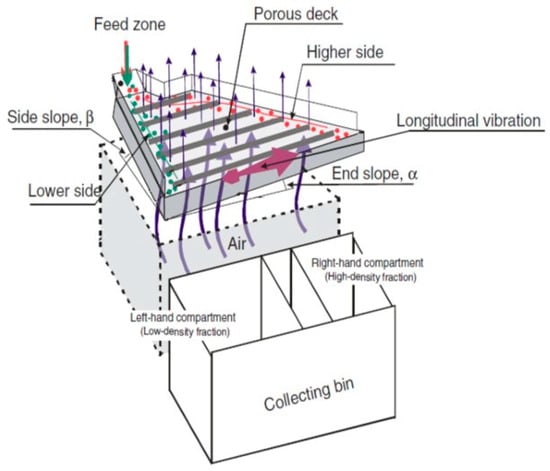
Figure 16.
The operating principle of an Air table with air flow depicted with dark purple arrows and longitudinal vibration motion with the big light purple arrow [83].
5. Upgraded Methods for Processing Alluvial Gold Deposits
5.1. The Spiral Concentrator
Spiral concentrators (Figure 17) are one of the most essential systems for the gravity concentration of gold. Spirals are often used to beneficiate a variety of ores, but probably their most widespread use has been in the treatment of heavy mineral sand deposits [84]. They first appeared as a production unit in 1943 as “Humphrey’s” spirals for separating chromite-bearing sand in Oregon. It consists of a helical conductor of 4–5 spirals with a modified circular cross-section. Furthermore, it has a water channel for flushing the particles and a series of exit points to collect the concentrated product. A complex system of centrifugal forces, differential settling, and displacement of heavy particles causes particle classification. Thus, the heavier particles progress to the inner profile of the spiral, while the lighter particles are forced towards the outer profile. Finally, three products (concentrate, middlings, and tailings) are collected.
The capacity of the spiral concentrator per hour depends on the ore to be processed and ranges from 1.3 to 1.8 tons per concentrator for most types of ores or minerals. At the same time, the water consumption is determined by the pulp density and varies between 3.3 and 8 m3/h, while the hutch water consumption varies between 0.6 and 1.6 m3/h. The larger and heavier particles are directed towards the lower part of the concentrator, and their velocity decreases due to the friction that develops on the surface of the spiral, causing them to shift towards the inner part of the spiral. In contrast, the finer and lighter particles stay on the outer portions of the spiral, remaining with the water and reaching the lower part faster. To accomplish a separation of the low and high-density fractions, adjustable separation blades are used. These blades are flexible, allowing them to control the direction of the heavier fractions, directing them into the pipes or collection vessels [85].
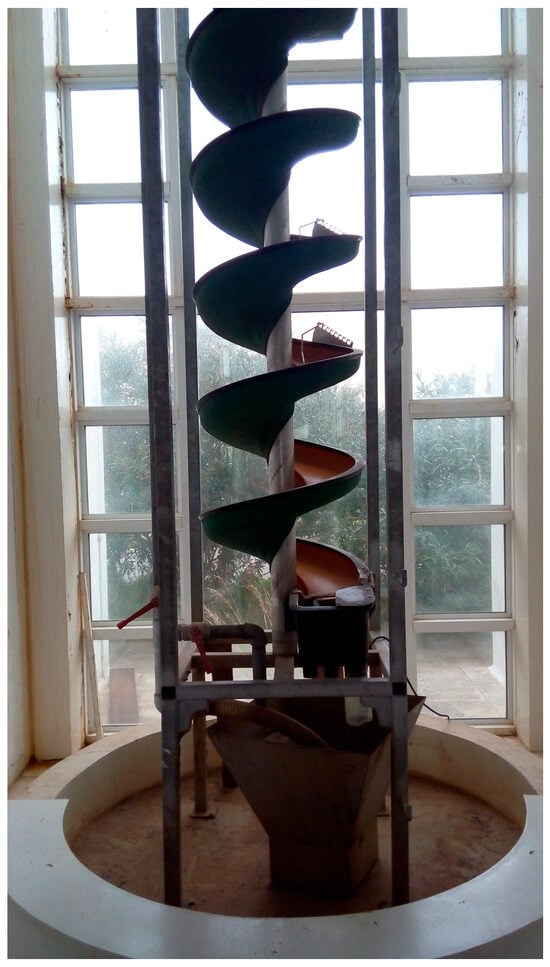
Figure 17.
Pictorial view of spiral concentrator (Technical University of Crete, Mineral Processing Laboratory).
The advantages of spiral concentrators include low cost, long service life, low installation space requirements (about 0.4 m2), and satisfactory recovery of fine-grained materials. In addition, they can be visually inspected with great ease, thus determining whether the material is properly separated. For maximum operational efficiency, the feed flow must be kept constant, the particle size distribution of the feed must be uniform, and fluctuations in volume must be minimised. At the same time, spiral concentrators, like conical concentrators, are efficient units that do not have high maintenance requirements, which would otherwise have to be considered.
Humphreys’ spirals can separate particles as small as 270 mesh (53 µm). In a test conducted at CSMRI (Colorado School of Mines Research Institute), the Reichert Mark VII spiral recovered 91.3% of the gold in free form within the feed, representing only 5.4% of its total weight. The unit showed a slight decrease in gold recovery efficiency, down to sizes up to 325 mesh (45 µm) [86].
5.2. The Jiggs Concentrator
Although jigging is one of the oldest methods of gravity concentration, its principles have only recently been understood. Mishra and Mehrotra [87] developed a new modelling approach based on Newtonian mechanics to study the stratification behavior of particles in a batch jig, whereas Xia et al. [88] used a microscopic model based on the principles of Computational Fluid Dynamics (CFD) to simulate the liquid flow and stratification of coal particles.
Jiggs are open and water-filled tanks with a horizontal screen in their upper part and a concentrate collection nozzle at the bottom. The mechanical pistons cause the water’s pulsating movement, thus separating particles with different specific gravity values. In order to achieve separation between particles of different specific gravity, there must be a difference in the settling rates of the solid particles being processed. More specifically, the heavier particles have a higher settling velocity than the lighters, so they remain in the lower part of the bed during the stratification. As a result, a portion of the heavy particles that pass through the screen holes is collected and placed back on its surface (ragging bed), allowing only the very high specific gravity particles to reach it and be further separated in the next feed [89].
The selection of the most suitable type of Jiggs concentrator is determined by several factors, including the bed’s geometry, the mechanism for generating the impulse water movement, the system for depositing the heavier pieces, and the control system. Sampaio and Tavares [90] introduced a classification of modern jigging devices that revolves around three primary factors:
- Screen condition (fixed or mobile);
- Heavy product’s extraction method;
- Mechanism for generating water’s pulsating movement.
As mentioned, the screen remains fixed in the most common types of Jiggs concentrators, and the water flows through the holes. However, in various other types of Jiggs concentrators, the layering of particles on the screen’s surface is achieved via vibration within the fluid. Currently, the models of concentrators in this category are the ROMJIG and Inline Pressure type Jiggs concentrators. The screen is vibrated vertically in both of the above devices through an appropriate hydraulic system connected to its surface [91].
Jiggs concentrators can be further classified based on the mechanism used to generate the pulse motion. There are concentrators with mechanical pulse drive mechanisms that operate through pistons or a diaphragm, as well as those that utilize compressed air intake for pulsating the water. One of the early mechanical Jiggs concentrators was the Harz-type concentrator. While the mechanical design and operation of the Harz-type concentrator were relatively simple, it faced challenges due to water leaks that occurred during the operation. The Jiggs concentrator operating using this arrangement was the Denver, which had a rotary valve that operated in synchronization with the piston, preventing the inflow of hutch water during the suction stroke. Compressed air instead of mechanical devices for pulsating the water first appeared in the late 19th century with the development of the Baum-type Jiggs concentrator. The key factor in the success of air pulse devices was the use of electronically controlled air valves to rapidly control the water flow [92].
Kelsey-type Jiggs concentrators have been developed in recent decades and are the best-known example of centrifugal concentrators. While their operation principle aligns with conventional Jiggs concentrators concerning the water‘s pulsating motion and the management of particle separation, Kelsey centrifugal concentrators employ an additional centrifugal “G” gravity force. Introducing this centrifugal gravity force increases the sensitivity of the separation, allowing finer particles and particles with similar specific gravity values to be separated. The Kelsey-type Jiggs concentrator can recover fine particles down to 10 μm. However, centrifugal jigs are the gravimetric separation devices that consume the largest amount of water (more than 15 m3/tonne of ore) [92] (Figure 18).
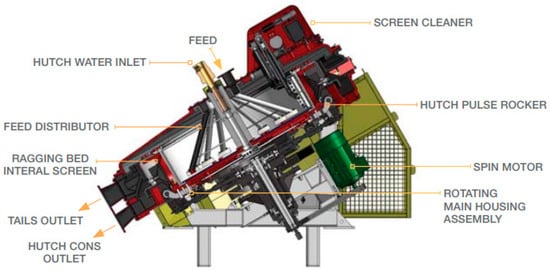
Figure 18.
Schematic illustration of the interior of a centrifugal Jiggs concentrator (Kelsey, CPG Resources-Mineral Technologies brochure).
Other alternative and more efficient devices include the Multi Gravity Separator, a promising equipment for processing of fine particles (maximum particle size of approximately 0.5 mm). The parameters that affect the MGS performance are the drum speed, tilt angle, shake amplitude/frequency, wash water flow rate, and feed solids [93,94,95,96]. Another apparatus is the Falcon; this device essentially combines a centrifuge that runs constantly with a sluice. It makes it possible to separate small particles of various specific gravities because of its fast rotational speed capability and strong “G” force [16,97,98]. Finally, it is worth mentioning the centrifugal concentrator, named after Byron Knelson, is a better and more sophisticated recovery technology than the sluice box and long tom that dominated the market in 1970. The rationale behind the Knelson design is contrasted with that of single-wall centrifugal concentrators from earlier and later years, which had remarkable industry acceptance [15,99,100,101,102].
5.3. Shaking Tables
The shaking table is one of the most versatile gravity concentration devices and consists of a slightly inclined deck with a rifled surface (Figure 19). The feed of about 25% solids by weight is introduced at the feed box and is distributed across the table using the combination of table motion and flow of water (wash water). The table is vibrated longitudinally, using a slow forward stroke and a rapid return, which causes the mineral particles to move along the deck parallel to the direction of motion. Consequently, the minerals are subjected to two forces, one due to the table motion, and the other at right angles to it due to the flowing film of water. The heavier particles accumulate between the riffles and the motion of the table moves them and finally discharge them at the corner diagonally opposite to the feed corner. The light particles that remain in suspension are washed across the table by the water due to the inclination of the table. The other particles (middlings) discharge at intermediate places between light and heavy particles [84,103].
The factors affecting the process include solids characteristics, e.g., size range, specific gravity, particle size and particle shape. In addition, the variables that must be considered are the tilt of the table from the horizontal, the amount of the solids and wash water and the position where they are added, the length of the motion stroke and the speed of the stroke [104].
The tonnage capacity of a specific sized table can range from 150 tons per 24 h for coarse feed to 15 tons per 24 h for very fine feed, depending on the feed size. While coarse feed typically requires a long, slow stroke with a lot of wash water, fine feed typically only needs a quick, brief stroke. The stroke frequency of a shaking table ranges from 180 to 300 strokes per minute, and the stroke length is generally 1.25–3.75 cm [103].
Shaking tables are successfully used to treat heavy minerals from beach sands, chromite beneficiation, gold ores, etc. These are normally operated on feed sizes in the range of 3 mm to 100 microns. The particles smaller than 100 microns are treated in slime tables whose decks have a series of planes rather than riffles [105].
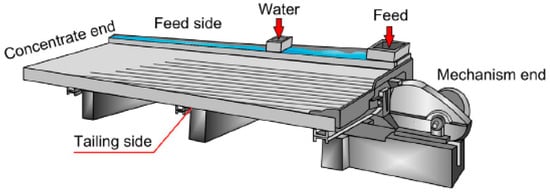
Figure 19.
Schematic illustration of a shaking table [84].
6. Discussion and Conclusions
Gold is one of the most desirable and useful metals in the world and has been widely used over the centuries. Even today, gold belongs to the precious metals, and apart from its constant value over time and its use in the manufacture of jewellery, it is also used in modern technologies in the manufacture of circuits due to its good electrical conductivity.
Placer gold has been exploited for thousands of years, with early methods of using sheepskin to encapsulate gold nuggets inspiring the myth of the Argonaut expedition and the Golden Fleece. The mining of alluvial gold deposits has yielded the most significant quantities compared to other sources. The gold panning is a widespread technique that is still used day, but it has the disadvantage of being a laborious process to concentrate small amounts of gold. As technology evolved, new devices were developed that were more efficient, including steam-driven devices and diesel engines. These devices were able to exploit gold deposits more efficiently and on a larger scale. In modern times, these machines are replaced by electrically powered ones to be as environmentally friendly as possible.
A special mention also needs to be made of the Agricola pumps that helped to exploit gold more efficiently. This scientist, doctor, architect, and philanthropist [106] helped to develop safe mining by providing a detailed description supported with sketches of many innovative devices.
Recovering and separating alluvial gold is much easier than mining gold from other types of deposits, making this type of exploitation quite interesting and widespread, causing the so-called gold rush. Even today, there is extensive exploitation of mainly riverine alluvial deposits, resulting in many small-scale operations around the world, raising the problem of environmental pollution depending on the recovery technique. The problem is more acute in countries without strict environmental legislation. Over the centuries and decades, the development and optimization of gold mining devices have focused on minimizing manual and laborious work while increasing overall efficiency through automation. Subsequently, the need to process a wider particle size range of gold particles and to shift from intermittent to continuous operation of the mechanisms was identified as important. Furthermore, efforts have been made to design devices with lower cleaning requirements, reduced water consumption, and decreased labour demands. Today, with the environmental crisis that earth is experiencing every day, it is necessary to develop gold recovery and processing devices, which should be more efficient, and produce less waste, which, with appropriate treatment, can be put into a cycle of use within the framework of the circular economy. In floodplains, placer mining is a technique for obtaining minerals that entails the removal of soil to gain access to sediments that are rich in minerals. Aquatic habitats may be negatively impacted by this process over a lengthy period of time. New technologies with high-resolution image analysis in today’s world can be used to mitigate the effects of these excavations [107].
The present work makes a historical review providing the primitive methods of extracting and processing gold and explores the evolution of different technologies from ancient times to the present. An exciting investigation of placer gold recovery was published in 1970 by Silva [51]. This work tries to go deeper into the time investigation to include all the techniques used for gold recovery. Studying these centuries-tested technologies of alluvial gold mining makes it easier to choose the most appropriate gold separation method depending on the deposit. Also, in many small-scale alluvial gold deposits, amalgamation is used [8], which is a technique that requires the use of mercury. In addition to the environmental concerns raised by Hg, it also has a high energy footprint, as recovering gold from amalgamation involves heat. So, it is necessary to find alternatives to replace this efficient technique based on the free-mercury devices [11].
Author Contributions
Conceptualization, E.M. and S.M.; methodology, E.M.; validation, G.X., E.P. and E.M.; resources, E.M. and S.M.; data curation, E.M.; writing—original draft preparation, S.M.; writing—review and editing, S.M., E.P., G.X. and E.M.; supervision, E.M.; project administration, E.M. All authors have read and agreed to the published version of the manuscript.
Funding
This research received no external funding.
Data Availability Statement
Not new data created here.
Conflicts of Interest
The authors declare no conflict of interest.
References
- Klemm, R.; Klemm, D. Archaeological Chronology of Gold Mining in Ancient Egypt and Nubian Sudan. In Natural Science in Archaeology; Springer: Berlin/Heidelberg, Germany, 2013; pp. 1–20. [Google Scholar] [CrossRef]
- Klemm, D.; Klemm, R. Mining in Ancient Egypt and Nubia. In Encyclopaedia of the History of Science, Technology, and Medicine in Non-Western Cultures; Springer: Dordrecht, The Netherlands, 2008; pp. 1685–1698. [Google Scholar] [CrossRef]
- Okrostsvaridze, A.; Gagnidze, N.; Akimidze, K. A Modern Field Investigation of the Mythical “Gold Sands” of the Ancient Colchis Kingdom and “Golden Fleece” Phenomena. Quat. Int. 2016, 409, 61–69. [Google Scholar] [CrossRef]
- Boyle, R.W. Gold during the Classical Period. In Gold; Springer: Boston, MA, USA, 1987; pp. 29–38. [Google Scholar] [CrossRef]
- Craddock, P.T. Agricola, De Re Metallica: A Landmark in the History of Metallurgy. Endeavour 1994, 18, 67–73. [Google Scholar] [CrossRef]
- Trujillo, F.J.; Claver, J.; Sevilla, L.; Sebastián, M.A. De Re Metallica: An Early Ergonomics Lesson Applied to Machine Design in the Renaissance. Sustainability 2021, 13, 9984. [Google Scholar] [CrossRef]
- Brooks, W.E.; Öztürk, H.; Cansu, Z. Amalgamation and Small-Scale Gold Mining at Ancient Sardis, Turkey. Archaeol. Discov. 2017, 5, 42–59. [Google Scholar] [CrossRef][Green Version]
- Soe, P.S.; Kyaw, W.T.; Arizono, K.; Ishibashi, Y.; Agusa, T. Mercury Pollution from Artisanal and Small-Scale Gold Mining in Myanmar and Other Southeast Asian Countries. Int. J. Environ. Res. Public Health 2022, 19, 6290. [Google Scholar] [CrossRef]
- Velásquez Ramírez, M.G.; Vega Ruiz, C.M.; Gomringer, R.C.; Pillaca, M.; Thomas, E.; Stewart, P.M.; Gamarra Miranda, L.A.; Dañobeytia, F.R.; Guerrero Barrantes, J.A.; Gushiken, M.C.; et al. Mercury in Soils Impacted by Alluvial Gold Mining in the Peruvian Amazon. J. Environ. Manag. 2021, 288, 112364. [Google Scholar] [CrossRef] [PubMed]
- Da Costa, M.A.; Rios, F.J. The Gold Mining Industry in Brazil: A Historical Overview. Ore Geol. Rev. 2022, 148, 105005. [Google Scholar] [CrossRef]
- Vieira, R. Mercury-Free Gold Mining Technologies: Possibilities for Adoption in the Guianas. J. Clean. Prod. 2006, 14, 448–454. [Google Scholar] [CrossRef]
- Brooks, W.E.; Sierra-Giraldo, J.A.; Palacios, F.M. Green Gold—Dirty Gold, Tadó, Dept. Chocó, Colombia. Nat. Resour. 2015, 6, 534–542. [Google Scholar] [CrossRef][Green Version]
- Alekseev, V.S.; Banshchikova, T.S. Rebellious Gold Extraction from Gravity Concentrates and Placer Tailings by Chemical Reagents. J. Min. Sci. 2018, 53, 756–761. [Google Scholar] [CrossRef]
- Clarkson, G.; Clarkson, R.; Hitch, M. Exploiting the Malleability of Gold for Placer Concentrate Extraction and Recovery. Miner. Eng. 2016, 94, 38–40. [Google Scholar] [CrossRef]
- Knelson, B. The Knelson Concentrator. Metamorphosis from Crude Beginning to Sophisticated World Wide Acceptance. Miner. Eng. 1992, 5, 1091–1097. [Google Scholar] [CrossRef]
- Falconer, A. Gravity Separation: Old Technique/New Methods. Phys. Sep. Sci. Eng. 2003, 12, 812865. [Google Scholar] [CrossRef]
- Harrell, J.A.; Brown, V.M. The World’s Oldest Surviving Geological Map: The 1150 B.C. Turin Papyrus from Egypt. J. Geol. 1992, 100, 3–18. [Google Scholar] [CrossRef]
- Oddy, A. Assaying in Antiquity. Gold Bull. 1983, 16, 52–59. [Google Scholar] [CrossRef]
- Lehner, J.W.; Yener, K.A.I. Organization and Specialization of Early Mining and Metal Technologies in Anatolia. In Archaeometallurgy in Global Perspective: Methods and Syntheses; Springer: Berlin/Heidelberg, Germany, 2014; ISBN 9781461490173. [Google Scholar] [CrossRef]
- De Jesus, P.; Dardeniz, G. Archaeological and Geological Concepts on the Topic of Ancient Mining. Bull. Miner. Res. Explor. 2015, 151, 231–246. [Google Scholar] [CrossRef][Green Version]
- Lordkipanidze, O. The Golden Fleece: Myth, Euhemeristic Explanation and Archaeology. Oxf. J. Archaeol. 2001, 20, 1–38. [Google Scholar] [CrossRef]
- Doumas, C. What Did the Argonauts Seek in Colchis? Hermathena 1991, 150, 31–41. Available online: https://www.jstor.org/stable/23040952 (accessed on 10 July 2023).
- Leonardos, I. The Argonaut Myth and the Metal Trade in the Mediterranean. Miner. Welth 2011. [Google Scholar]
- Kakridis, I. Greek Mythology; Athenon SA: Athens, Greece, 1986; Volume 5. [Google Scholar]
- Rodríguez, R.M. La Minería Aurífera Romana Del Noroeste de Hispania: Inge-niería Minera y Gestión de Las Explotaciones Auríferas Romanas En La Sierra Del Teleno (León-España). In Nuevos Elementos de Ingeniería Romana (III Congreso de las Obras Públicas Romanas); University of La Rioja: La Rioja, Spain, 2006. [Google Scholar]
- Lima, A.; Matias, R.; Fonte, J.A. Exploração de Depósitos Secundários de Ouro Nas Serras de Santa Justa e Pias (Município de Valongo). In Proceedings of the Atas do 1 Congresso de Mineração Romana em Valongo, Valongo, Portugal, 8–9 November 2014; pp. 40–47. [Google Scholar]
- Del Mar, A. A History of the Precious Metals, 2nd ed.; Cambridge Encyclopedia Company: New York, NY, USA, 1901. [Google Scholar] [CrossRef]
- Aller, J.; Bastida, F.; Bulnes, M.; Fernández, F.J.; Poblet, J. Field Trip in Honour of the Work of Prof. Richard J. Lisle. The Roman Gold Mine of Las Médulas; University of Oviedo: Oviedo, Spain, 2013. [Google Scholar]
- Redondo-Vega, J.M.; Alonso-Herrero, E.; Santos-González, J.; González-Gutiérrez, R.B.; Gómez-Villar, A. La Balouta Exhumed Karst: A Roman Gold-Mine-Derived Landscape within the Las Médulas UNESCO World Heritage Site (Spain). Int. J. Speleol. 2015, 44, 267–276. [Google Scholar] [CrossRef]
- Hirt, A. Gold and Silver Mining in the Roman Empire. In Debasement. Manipulation of Coin Standards in Pre-Modern Monetary Systems; Butcher, K., Ed.; Oxbow Books: Oxford, PA, USA, 2020; ISBN 978-1-78925-401-3. [Google Scholar]
- Zevgolis, E.N. Gold Metallurgy and Environmental Impacts. The International Experience. In Proceedings of the TEE Conference, Athens, Greece, 6–8 May 2003. [Google Scholar]
- John, L.W. The Art of Heap Leaching—The Fundamentals; The South African Institute of Mining and Metallurgy: Johannesburg, South Africa, 2011. [Google Scholar]
- Ruiz del Árbol Moro, M.; Sánchez-Palencia Ramos, F.J.; Sastre Prats, I.; Orejas Saco del Valle, A. Water Networks of Roman Gold Mines of Northwestern Iberian Peninsula. Water Hist. 2014, 6, 95–113. [Google Scholar] [CrossRef]
- Pérez-García, L.C.; Sánchez-Palencia, F.J.; Torres-Ruiz, J. Tertiary and Quaternary Alluvial Gold Deposits of Northwest Spain and Roman Mining (NW of Duero and Bierzo Basins). J. Geochem. Explor. 2000, 71, 225–240. [Google Scholar] [CrossRef]
- Brooks, W.E. Enigma of Alluvial Gold Mining in Pre-Contact Peru—The Present Is Key to the Past. Archaeol. Discov. 2023, 11, 39–64. [Google Scholar] [CrossRef]
- Tripcevich, N.; Vaughn, K.J. Mining and Quarrying in the Ancient Andes; Springer: New York, NY, USA, 2013; ISBN 978-1-46145-199-0. [Google Scholar]
- Berthelot, J. The Extraction of Precious Metals at the Time of the Inka. In Anthropological History of Andean Polities; Cambridge University Press: Cambridge, UK, 2010. [Google Scholar]
- Van Buren, M.; Presta Prof, A.M. The Organization of Inka Silver Production in Porco, Bolivia. In Distant Provinces in the Inka Empire: Toward a Deeper Understanding of Inka Imperialism; University of Iowa Press: Iowa City, IA, USA, 2010. [Google Scholar]
- Fisher, J.R. Gold in the Search for the Americas. Gold Bull. 1976, 9, 58–63. [Google Scholar] [CrossRef]
- Brown, K.W. The Lure of Gold, the Wealth of Silver. In A History of Mining in Latin America: From the Colonial Era to the Present; University of New Mexico Press: Albuquerque, NM, USA, 2012. [Google Scholar]
- Frank, L.; Galvin, M.; Skinner, M. Mining and Metallurgy to the Renaissance; Worcester Polytechnic Institute: Worcester, UK, 1999. [Google Scholar]
- Hoover, H.C.; Hoover, L.H. Georgius Agricola, De Re Metallica; Translated from 1556; Dover Publications Inc.: New York, NY, USA, 1950. [Google Scholar]
- Agricola, G. The Project Gutenberg, Ebook of De Re Metallica. 1912. Available online: https://www.gutenberg.org/files/38015/38015-h/38015-h.htm (accessed on 5 August 2023).
- Paddison, J.E. 1848–1865: Gold Rush, Statehood, and the Western Movement; California Cultures Project; University of California: Los Angeles, CA, USA, 2005. [Google Scholar]
- Curtis, J.A.; Flint, L.E.; Alpers, C.N.; Wright, S.A.; Snyder, N.P. Use of Sediment Rating Curves and Optical Backscatter Data to Characterize Sediment Transport in the Upper Yuba River Watershed, California; USGS Publications Warehouse: Sacramento, CA, USA, 2006. [Google Scholar] [CrossRef]
- Hines, E.; Smith, M. Gold Is Where You Find It: Placer Mining in North Carolina, 1799–1849. Earth Sci. Hist. 2002, 21, 119–149. [Google Scholar] [CrossRef]
- Teschner, B.; Smith, N.M.; Borrillo-Hutter, T.; John, Z.Q.; Wong, T.E. How Efficient Are They Really? A Simple Testing Method of Small-Scale Gold Miners’ Gravity Separation Systems. Miner. Eng. 2017, 105, 44–51. [Google Scholar] [CrossRef]
- Wells, J.H. Placer Examination Principles and Practice; Technical Bulletin 4; Bureau of Land Management: Phoenix, AZ, USA, 1969.
- Grayson, R. Gold Recovery in Gold Pans—the Term “Panning”. World Placer J. 2006, 6, 1–21. [Google Scholar]
- Veiga, M.; Metcalf, S.; Baker, R.; Klein, B.; Davis, G.; Bamber, A.; Siegel, S.; Singo, P. Manual for Training Artisanal and Small-Scale Gold Miners; UNIDO: Vienna, Austria, 2006. [Google Scholar]
- Silva, M. Placer Gold Recovery Methods. Int. Geol. Rev. 1970, 12, 1–40. [Google Scholar]
- Agyei, G.; Gordon, J.J. Effect of Riffle Height and Spacing of a Sluice Board on Placer Gold Recovery. Ghana Min. J. 2017, 17, 64–72. [Google Scholar] [CrossRef]
- West, J.M. How to Mine and Prospect for Placer Gold; U.S. Bureau of Mines, Information Circular: Pittsburgh, PA, USA, 1971.
- Jennings, H. The History and Development of Gold Dredging in Montana/Placer Mining Methods and Operating Costs; Forgotten Books: London, UK, 1916. [Google Scholar]
- Grayson, R.F. Bucket-Line Gold Dredges—A Review of World Techniques. World Placer J. 2008, 8, 1–41. [Google Scholar]
- Purdy, S.E. Analysis of Dredge Tailings Pile Patterns: Applications for Historical Archaeological Research. Master’s Thesis, Oregon State University, Corvallis, OR, USA, 2007. [Google Scholar]
- Yannopoulos, J.C. The Extractive Metallurgy of Gold; Springer: Boston, MA, USA, 1991; ISBN 978-1-46848-427-4. [Google Scholar]
- Gardner, E.D. Power-Shovel and Dragline Placer Mining; University of Michigan Library: Ann Arbor, MI, USA, 1938. [Google Scholar]
- Coggin, M.H. A History of Placer Mining in Arizona. In History of Mining in Arizona Inc; Canty, M.J., Greeley, M.N., Eds.; Mining Club of the Southwest Foundation: Tucson, AZ, USA, 1987; pp. 177–190. [Google Scholar]
- Lewis, W.; Balderstone, S.; Bowan, J. Events That Shaped Australia; New Holland: Wahroonga, NSW, Australia, 2006. [Google Scholar]
- Simon, D. (Ed.) Gravity Gold 2010; The Australasian Institute of Mining and Metallurgy: Ballarat, VIC, Australia, 2010; ISBN 978-1-62198-109-1. [Google Scholar]
- Lawrence, S.; Davies, P. Innovation, Adaptation and Technology as Habitus: The Origins of Alluvial Gold Mining Methods in Australia. Archaeol. Ocean. 2015, 50, 20–29. [Google Scholar] [CrossRef]
- Davies, P.; Lawrence, S.; Turnbull, J.; Rutherfurd, I.; Grove, J.; Silvester, E.; Macklin, M. Mining Modification of River Systems: A Case Study from the Australian Gold Rush. Geoarchaeology 2020, 35, 384–399. [Google Scholar] [CrossRef]
- Zhang, R.; Pian, H.; Santosh, M.; Zhang, S. The History and Economics of Gold Mining in China. Ore Geol. Rev. 2015, 65, 718–727. [Google Scholar] [CrossRef]
- Hume, J.; Arceneaux, N. Glittering Dust, Dormant Treasure: Press, Public Memory and Georgia’s “Forgotten” Gold Rush. Am. Journal. 2006, 23, 7–33. [Google Scholar] [CrossRef]
- Malloch, K.; Kerr, G.; Craw, D. Placer Gold in the Cretaceous Blue Spur Conglomerate at Waitahuna, Southern New Zealand. N. Z. J. Geol. Geophys. 2017, 60, 239–254. [Google Scholar] [CrossRef]
- Knight, J. Transforming the Physical Geography of a City: An Example of Johannesburg, South Africa. In Urban Geomorphology: Landforms and Processes in Cities; Elsevier: Amsterdam, The Netherlands, 2018. [Google Scholar] [CrossRef]
- Mayers, E.G. The Klondike Gold Rush. Soc. Stud. Young Learn. 2008, 20, 12–15. [Google Scholar]
- Allen, D.W. Information Sharing During the Klondike Gold Rush. J. Econ. Hist. 2007, 67, 944–967. [Google Scholar] [CrossRef]
- DeFerreira, T.H.; Rios, F.J. The Miguel Burnier District: An Encapsulation of Brazil’s Mining History. Extr. Ind. Soc. 2021, 8, 101006. [Google Scholar] [CrossRef]
- Jedwab, J.; Cassedanne, J. Historical Observations on Oxygen-Bearing Compounds of Platinum and Palladium in Minas Gerais, Brazil. Can. Mineral. 1998, 36, 887–893. [Google Scholar]
- Cabral, A.R.; Lehmann, B. Seleniferous Minerals of Palladium and Platinum from Ouro Preto-Bearing Mineralisation in Brazil. Ore Geol. Rev. 2007, 32, 681–688. [Google Scholar] [CrossRef]
- Julio, J.B. Colonial Senses I. Gold Rush and Wild Life in Tierra Del Fuego, 1880–1914. Magallania 2010, 38, 5–26. [Google Scholar] [CrossRef]
- Grayson, R. Anatomy of the People’s Gold Rush in Modern Mongolia. World Placer J. 2007, 7, 1–66. [Google Scholar]
- Baraybar Hidalgo, V.; Dargent, E. State Responses to the Gold Rush in the Andes (2004–2018): The Politics of State Action (and Inaction). Stud. Comp. Int. Dev. 2020, 55, 516–537. [Google Scholar] [CrossRef]
- Habashi, F. Gold in Siberia—A Historical Essay. Metall 2013, 67. [Google Scholar]
- Hirons, M. Shifting Sand, Shifting Livelihoods? Reflections on a Coastal Gold Rush in Ghana. Resour. Policy 2014, 41, 83–89. [Google Scholar] [CrossRef]
- Yuliyanti, A.; Aminuddin, A. Mercury Contamination in Artisanal Gold Mining Sites in Indonesia and the Remediation; EAI: Gent, Belgium, 2023. [Google Scholar]
- Saliou, B.M.; Huang, X. A Critical Analysis of Gold Prospecting Methods. Int. J. Geosci. 2020, 11, 15–24. [Google Scholar] [CrossRef]
- Arief, T.; Machmud, H.; Oktinasari, E. Design of Air Table Equipment for the Separation of Metal Minerals by Gravity Concentration with Wind Media. Int. J. Miner. Process. Extr. Metall. 2022, 7, 43. [Google Scholar] [CrossRef]
- Burt, R. Role of Gravity Concentration in Modern Processing Plants. Miner. Eng. 1999, 12, 1291–1300. [Google Scholar] [CrossRef]
- Chalavadi, G.; Singh, R.K.; Das, A. Processing of Coal Fines Using Air Fluidization in an Air Table. Int. J. Miner. Process. 2016, 149, 9–17. [Google Scholar] [CrossRef]
- Lahtela, V.; Kärki, T. Mechanical Sorting Processing of Waste Material Before Composite Manufacturing—A Review. J. Eng. Sci. Technol. Rev. 2018, 11, 35–46. [Google Scholar] [CrossRef]
- Wills Barry, A. Will’s Mineral Processing Technology, An Introduction to the Practical Aspects of Ore Treatment and Mineral Recovery; Elsevier: Amsterdam, The Netherlands, 2013; Volume 1. [Google Scholar] [CrossRef]
- Fragiskos, A.; Katrakis, S. Introduction to the Mineral Processing of Metallic Ores and Industrial Minerals; Technical Chamber of Greece: Athens, Greece, 1979. [Google Scholar]
- Spiller, D.E. Gravity Separation of Gold—Then and Now; Colorado School of Mines Research Institute: Golden, CO, USA, 1983. [Google Scholar]
- Mishra, B.K.; Mehrotra, S.P. Modelling of Particle Stratification in Jigs by the Discrete Element Method. Miner. Eng. 1998, 11, 511–522. [Google Scholar] [CrossRef]
- Xia, Y.; Peng, F.F.; Wolfe, E. CFD Simulation of Fine Coal Segregation and Stratification in Jigs. Int. J. Miner. Process. 2007, 82, 164–176. [Google Scholar] [CrossRef]
- Swapan, K.H. Mineral Exploration. In Mineral Exploration Principles and Applications; Elsevier: Amsterdam, Netherlands, 2018; Chapter 12: Mineral Processing; pp. 259–290. ISBN 978-0-12814-022-2. [Google Scholar]
- Sampaio, C.H. Beneficiamento Gravimétrico: Uma Introdução Aos Processos de Concentração Mineral e Reciclagem de Materiais por Densidade; Editora da UFRGS: Porto Allegre, Brazil, 2005. [Google Scholar]
- Nesbitt, A.B.; Breytenbach, W.; van der Plas, P.J. Characterizations of the Pulse Wave of an Inline Pressure Jig in a near Density Application. Miner. Eng. 2005, 18, 1–7. [Google Scholar] [CrossRef]
- Ambrós, W.M. Jigging: A Review of Fundamentals and Future Directions. Minerals 2020, 10, 998. [Google Scholar] [CrossRef]
- Aslan, N. Multi-Objective Optimization of Some Process Parameters of a Multi-Gravity Separator for Chromite Concentration. Sep. Purif. Technol. 2008, 64, 237–241. [Google Scholar] [CrossRef]
- Roy, S. Recovery Improvement of Fine Iron Ore Particles by Multi Gravity Separation. Open Miner. Process. J. 2009, 2, 17–30. [Google Scholar] [CrossRef]
- Chan, B.S.K.; Mozley, R.H.; Childs, G.J.C. Extended Trials with the High Tonnage Multi-Gravity Separator. Miner. Eng. 1991, 4, 489–496. [Google Scholar] [CrossRef]
- Çiçek, T.; Cöcen, I.; Engin, V.T.; Cengizler, H. An Efficient Process for Recovery of Fine Coal from Tailings of Coal Washing Plants. Energy Sources Part A Recovery Util. Environ. Eff. 2008, 30, 1716–1728. [Google Scholar] [CrossRef]
- Honaker, R.Q.; Wang, D.; Ho, K. Application of the Falcon Concentrator for Fine Coal Cleaning. Miner. Eng. 1996, 9, 1143–1156. [Google Scholar] [CrossRef]
- Lins, F.F.; Veiga, M.M.; Stewart, J.A.; Papalia, A.; Papalia, R. Performance of a New Centrifuge (Falcon) in Concentrating a Gold Ore from Texada Island, B.C., Canada. Miner. Eng. 1992, 5, 1113–1121. [Google Scholar] [CrossRef]
- Laplante, A.R.; Woodcock, F.; Noaparast, M. Predicting Gravity Separation Gold Recoveries. Miner. Metall. Process. 1995, 12, 74–79. [Google Scholar] [CrossRef]
- Greenwood, M.; Langlois, R.; Waters, K.E. The Potential for Dry Processing Using a Knelson Concentrator. Miner. Eng. 2013, 45, 44–46. [Google Scholar] [CrossRef]
- Uslu, T.; Sahinoglu, E.; Yavuz, M. Desulphurization and Deashing of Oxidized Fine Coal by Knelson Concentrator. Fuel Process. Technol. 2012, 101, 94–100. [Google Scholar] [CrossRef]
- Olyaei, Y.; Aghazadeh, S.; Gharabaghi, M.; Mamghaderi, H.; Mansouri, J. Gold, Mercury, and Silver Extraction by Chemical and Physical Separation Methods. Xiyou Jinshu Cailiao Yu Gongcheng/Rare Met. Mater. Eng. 2016, 45, 2784–2789. [Google Scholar] [CrossRef]
- Gill, C.B. Materials Beneficiation; Springer: New York, NY, USA, 1991; ISBN 978-1-46127-763-7. [Google Scholar]
- Mular, A.L.; Halbe, D.N.; Barratt, D.J. Mineral Processing Plant Design, Practice, and Control: Proceedings; Society for Mining, Metallurgy, and Exploration: Englewood, CO, USA, 2002; Volumes 1–2. [Google Scholar]
- Subba Rao, D.V. Mineral Beneficiation; CRC Press: Boca Raton, FL, USA, 2011; ISBN 978-0-42920-632-0. [Google Scholar]
- Weber, L.W. Georgius Agricola (1494–1555): Scholar, Physician, Scientist, Entrepreneur, Diplomat. Toxicol. Sci. 2002, 69, 292–294. [Google Scholar] [CrossRef] [PubMed]
- Malik, K.; Robertson, C.; Braun, D.; Greig, C. U-Net Convolutional Neural Network Models for Detecting and Quantifying Placer Mining Disturbances at Watershed Scales. Int. J. Appl. Earth Obs. Geoinf. 2021, 104, 102510. [Google Scholar] [CrossRef]
Disclaimer/Publisher’s Note: The statements, opinions and data contained in all publications are solely those of the individual author(s) and contributor(s) and not of MDPI and/or the editor(s). MDPI and/or the editor(s) disclaim responsibility for any injury to people or property resulting from any ideas, methods, instructions or products referred to in the content. |
© 2023 by the authors. Licensee MDPI, Basel, Switzerland. This article is an open access article distributed under the terms and conditions of the Creative Commons Attribution (CC BY) license (https://creativecommons.org/licenses/by/4.0/).